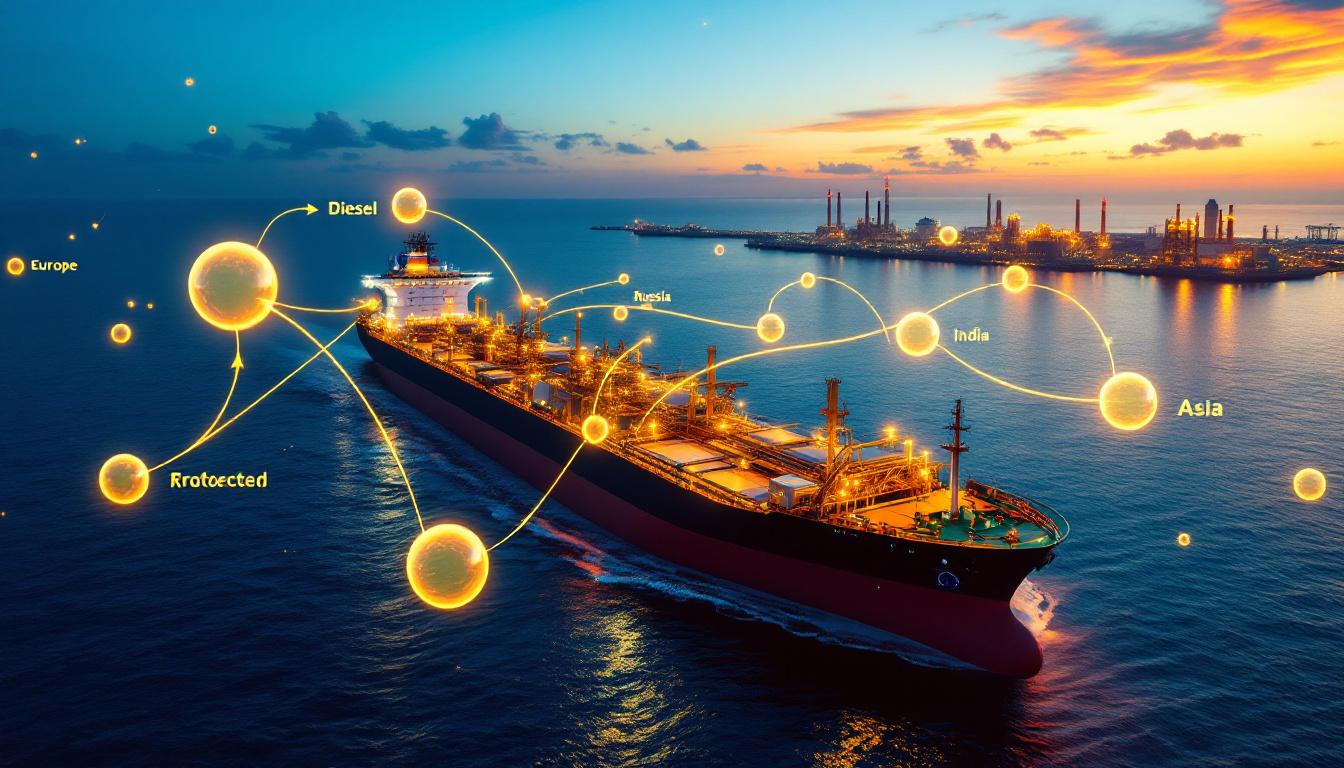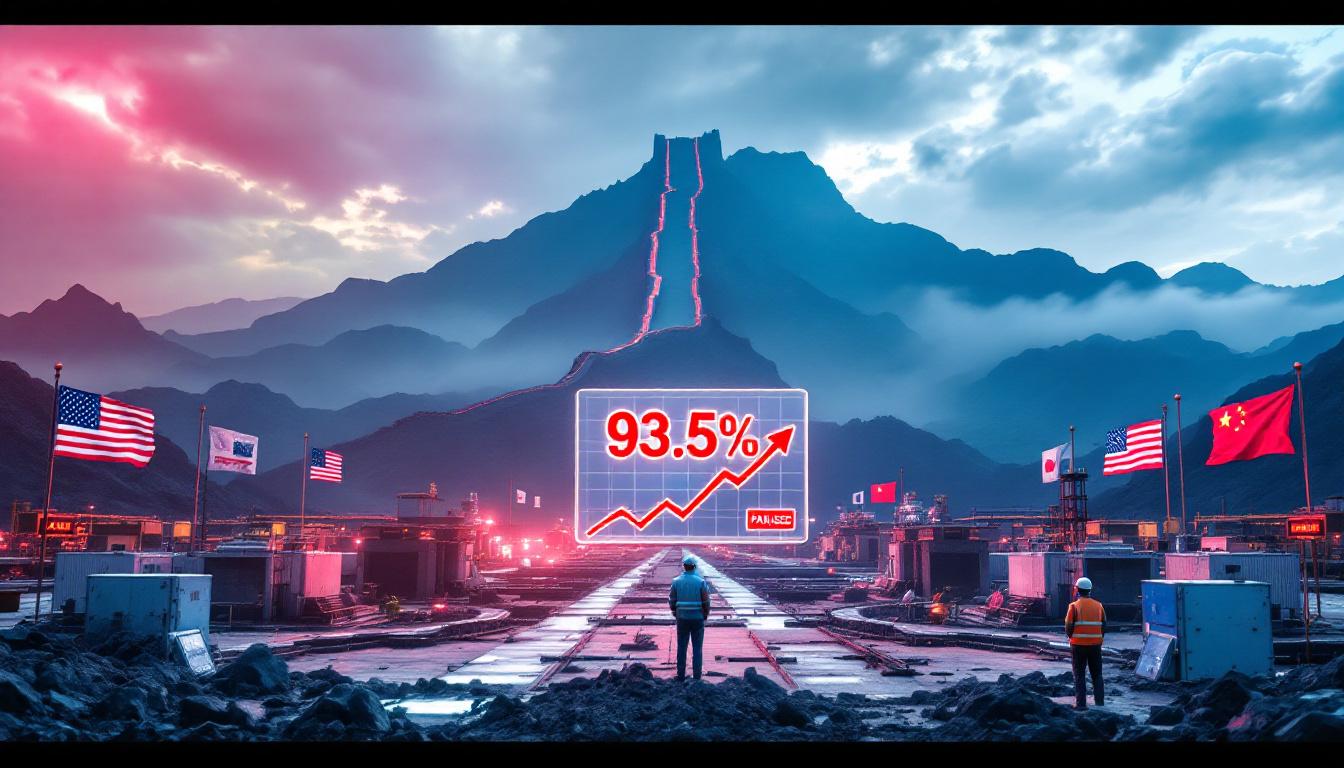Understanding Ramaco Resources' Expansion into Rare Earth Mining
Ramaco Resources, traditionally known for metallurgical coal production, has made headlines with its strategic pivot into the rare earth elements (REE) sector. The company's Brook Mine project in Wyoming represents not just a business diversification but potentially a transformative development for America's critical minerals strategy. With China currently controlling 80-90% of global rare earth processing, this domestic discovery carries significant implications for U.S. technological independence and national security.
How Ramaco Resources is Transforming from Coal to Critical Minerals
Ramaco's evolution from a coal-focused enterprise to a potential rare earth powerhouse demonstrates remarkable strategic foresight. The company identified an opportunity to leverage its mining expertise while addressing a critical national need for domestic rare earth production. This pivot reflects broader industry trends as traditional mining companies seek to position themselves within the clean energy and advanced technology supply chains.
"This discovery fundamentally alters U.S. critical mineral independence," stated Randall Atkins, CEO of Ramaco Resources, during a recent CNBC interview. His confidence stems from preliminary assessments indicating that the Brook Mine contains approximately 1.2 billion pounds of total rare earth oxides (TREO), positioning it as one of North America's most significant rare earth deposits.
What makes this discovery particularly valuable is the concentration of heavy rare earths—especially dysprosium and terbium—which constitute approximately 35% of the Brook Mine's resource. This percentage is unusually high compared to global averages and significantly enhances the deposit's strategic value.
The Brook Mine Project: Location and Resource Assessment
Geographic and Geological Significance
Located near Sheridan, Wyoming (41°15'18"N 106°44'05"W), the Brook Mine sits atop what geologists classify as a carbon-hosted ionic adsorption clay deposit. This unique geology enables lower-cost extraction methods, including potential in-situ leaching techniques that could dramatically reduce environmental impact compared to traditional rare earth mining operations.
Dr. Michael N. Evans, a geologist at the University of Wyoming, explains the site's advantages: "Brook Mine's geology allows selective mining—high-value zones are accessible with minimal overburden removal." This geological configuration translates to potential operational efficiencies that could position Ramaco competitively in the global market.
Resource Quality and Composition
The Brook Mine's resource grade averages 0.45% TREO, with magnet rare earths (neodymium and praseodymium) comprising approximately 20% of the concentrate. While this grade might appear modest compared to some international deposits, the site's exceptional concentration of heavy rare earths—which command significantly higher prices—enhances its economic viability.
According to Ramaco's technical disclosures in recent SEC filings, the deposit contains unusually high concentrations of dysprosium and terbium—approximately 2.6 times higher than those found at Mountain Pass, currently America's only operating rare earth mine. These elements are particularly crucial for high-performance permanent magnets used in electric vehicles, wind turbines, and advanced defense systems.
Why Are Rare Earth Elements Becoming Increasingly Strategic?
What Makes Rare Earth Elements Critical to Modern Technology?
Rare earth elements serve as indispensable components in numerous high-tech applications despite being used in relatively small quantities. A typical electric vehicle motor, for instance, requires approximately 1.5 kg of neodymium, according to Benchmark Mineral Intelligence. Wind turbines demand even greater quantities—a single 3MW turbine can contain up to 650 kg of rare earth materials.
The defense sector represents another critical application area. The Pentagon's Supply Chain Assessment reveals that each F-35 fighter jet incorporates approximately 417 kg of rare earth materials across various systems. Medical technology also depends heavily on these elements, with MRI machines requiring significant amounts of gadolinium, dysprosium, and other rare earths.
"Western defense contractors currently face 18-month lead times for terbium acquisition. This represents not just a supply chain issue but a genuine national security bottleneck." — Dr. Julie Klinger, author of "Rare Earth Frontiers"
The Global Supply Chain Challenge
The current rare earth supply chain presents significant vulnerabilities for Western economies. China processes approximately 92% of global heavy rare earths, according to Adamas Intelligence's "State of the Rare Earths Market" report from Q1 2025. This market dominance has led to price volatility—dysprosium prices, for example, rose 300% between 2020 and 2024.
This concentration of processing capacity gives China extraordinary leverage over industries dependent on these materials. Previous export restrictions have demonstrated how supply disruptions can impact global markets, with rare earth prices sometimes fluctuating by over 50% in response to policy changes.
The U.S. government has recognized this vulnerability, allocating $350 million through the Defense Production Act specifically for rare earth supply chain development. The recent US minerals executive order further highlights the strategic importance of developing domestic sources. Ramaco's Brook Mine project aligns perfectly with these national priorities, potentially reducing America's near-total dependence on imported heavy rare earths.
Examining the Economic Impact of Ramaco's Rare Earth Venture
Investment and Development Requirements
Developing a rare earth mine and processing facility requires substantial capital investment. According to Ramaco's project feasibility summary, the company anticipates capital expenditures of approximately $850 million for Phase 1 development. This includes mine construction, processing facilities, and supporting infrastructure.
Ramaco plans to execute development in multiple phases:
- Exploration and Resource Definition (Completed): Initial assessment with ongoing refinement
- Feasibility Studies (Current phase): Technical and economic viability assessment
- Permitting Process (Underway): Environmental and regulatory approvals
- Construction and Development: Targeted to begin within 18-24 months
- Production Commencement: Expected within 3-5 years
A significant advantage for Ramaco is the ability to repurpose approximately 80% of existing coal mining infrastructure at the site, according to the company's 2024 Sustainability Report. This reduces both capital requirements and environmental impact compared to greenfield development.
Projected Revenue and Market Opportunity
The rare earth market presents a substantial revenue opportunity for Ramaco Resources. Current market pricing for heavy rare earths like dysprosium ($450-500/kg) and terbium ($1,200-1,500/kg) far exceeds that of light rare earths like cerium ($5-7/kg) and lanthanum ($4-6/kg).
Given Brook Mine's favorable concentration of heavy rare earths, the project could potentially generate annual revenues several times higher than Ramaco's current coal operations once at full production. Industry analysts project that by 2030, the global rare earth market will exceed $15 billion annually, with heavy rare earths accounting for approximately 40% of that value despite representing a much smaller volume of the total market.
How Does Ramaco Plan to Extract and Process Rare Earth Elements?
Mining Methodology and Extraction Techniques
Ramaco is implementing innovative approaches to rare earth mining that differ significantly from traditional methods. According to Mining.com, the company plans to utilize room-and-pillar mining techniques combined with robotic sorting technology. This approach is expected to reduce waste handling by approximately 30% compared to conventional methods.
The company has also filed patents (WO/2025/036521) for a proprietary extraction method called "SolvEx," which reportedly reduces acid consumption by 40% compared to conventional rare earth processing. This technology addresses one of the most environmentally challenging aspects of rare earth production.
Table: Comparison of Extraction Methods
| Method | Acid Usage | Water Requirements | Energy Consumption | Recovery Rate |
|---|---|---|---|---|
| Conventional | High | 15-20 m³/ton | 4500-5500 kWh/ton | 85-90% |
| SolvEx (Ramaco) | Reduced by 40% | 8-10 m³/ton | 3200-3800 kWh/ton | 90-95% |
| In-situ Leaching | Moderate | 5-8 m³/ton | 2000-2500 kWh/ton | 70-80% |
Processing Challenges and Solutions
Processing rare earth elements presents unique challenges due to their chemical similarities. Ramaco is addressing these challenges through a combination of proven technologies and innovative approaches:
- Selective Precipitation: Using pH-controlled reactions to separate individual elements
- Solvent Extraction: Multi-stage process to achieve high-purity separation
- Co-product Strategy: Extracting vanadium and gallium from tailings to improve economics
The company is also exploring partnerships with established rare earth processors like Estonia's Silmet plant to potentially fast-track product development while building domestic capacity. This hybrid approach could allow Ramaco to generate revenue while developing full vertical integration capabilities.
What Impact Will This Project Have on U.S. Rare Earth Supply?
Contribution to Domestic Critical Mineral Security
The Brook Mine project could significantly reduce U.S. dependency on imported rare earth materials. Currently, the United States imports approximately 87% of its rare earth materials from China, according to U.S. International Trade Commission data. Ramaco's production could potentially cut this dependency by half for certain critical elements.
Simon Moores, CEO of Benchmark Mineral Intelligence, noted that "Wyoming's deposits could reduce U.S. magnet import reliance by 50% by 2030 if developed at projected capacity." This reduction would substantially strengthen America's technological supply chain resilience, particularly for defense and clean energy applications.
The project also aligns with the CHIPS and Science Act and the Inflation Reduction Act, both of which incentivize domestic production of critical minerals. The recent executive order on critical minerals further emphasizes this national priority. Ramaco may qualify for tax credits and other financial incentives under these programs, enhancing the project's economic viability while advancing national strategic objectives.
Competitive Landscape Analysis
Ramaco's Brook Mine will enter a competitive landscape with few domestic players but significant international competition. Currently, MP Materials' Mountain Pass mine in California represents the only major U.S. rare earth production facility, though it focuses primarily on light rare earths and still sends materials to China for processing.
Several other U.S. projects are in development, including:
- USA Rare Earth: Round Top project in Texas
- Ucore Rare Metals: Bokan Mountain in Alaska
- Energy Fuels: Processing initiatives in Utah
However, Brook Mine's advantage lies in its high concentration of heavy rare earths, which these other projects generally lack. This differentiation could position Ramaco to capture a high-value segment of the market with less direct competition.
What Challenges Must Ramaco Overcome?
Technical and Operational Hurdles
Developing a rare earth mine and processing facility presents significant technical challenges:
- Separation Complexity: Rare earth elements have similar chemical properties, making separation difficult and expensive
- Processing Expertise: Limited domestic experience in rare earth processing requires building specialized teams
- Scale-up Risks: Moving from laboratory success to commercial production often introduces unforeseen challenges
- Product Certification: Meeting exacting specifications for high-tech applications requires rigorous quality control
Ramaco is addressing these challenges by assembling a specialized technical team with experience in critical minerals development. The company has also established partnerships with research institutions, including the Critical Materials Institute at Ames Laboratory, to access cutting-edge separation technologies.
Regulatory and Environmental Considerations
Rare earth mining has historically faced environmental scrutiny due to issues with radioactive waste management and acid usage. Effective mine reclamation strategies will be essential for the project's long-term sustainability. Ramaco's environmental strategy includes:
- Water Management: Closed-loop water systems recycling up to 85% of process water
- Tailings Approach: Dry-stack tailings to minimize risk of containment failures
- Progressive Reclamation: Rehabilitating mined areas concurrent with operations
- Carbon Footprint: Targeting 0.8 tons CO2e per ton TREO vs. industry average of 2.1 tons
The permitting process for the Brook Mine involves coordination with multiple agencies, including the Wyoming Department of Environmental Quality, the U.S. Army Corps of Engineers, and potentially the Nuclear Regulatory Commission due to the presence of thorium in some rare earth deposits.
How Might Investors Evaluate Ramaco's Rare Earth Strategy?
Financial Implications for Ramaco Resources
Ramaco's entry into rare earth production represents both opportunity and risk for investors. The company's market capitalization could expand significantly if the project succeeds, given the higher margins typically associated with rare earth production compared to metallurgical coal.
Key financial considerations include:
- Capital Intensity: The $850 million Phase 1 investment represents a substantial commitment relative to Ramaco's current market capitalization
- Time to Revenue: 3-5 year development timeline before significant revenue generation
- Dual Business Model: Maintaining coal operations while developing rare earth capabilities creates operational complexity
- Margin Potential: Gross margins for rare earth products can exceed 60% for separated oxides, compared to 30-40% for metallurgical coal
For investors, the project offers exposure to the clean energy and advanced technology sectors while maintaining the company's traditional coal business as a revenue foundation during development.
Key Performance Indicators to Monitor
Investors should track several metrics to evaluate Ramaco's progress:
- Permitting Milestones: Regulatory approvals that unlock development phases
- Processing Technology Validation: Demonstration of separation capabilities at pilot scale
- Strategic Partnerships: Agreements with end-users or processing partners
- Capital Allocation: Balance between coal operations and rare earth development
- Production Cost Projections: Updates to operating cost estimates as development progresses
"The rare earth sector rewards patient capital. Development timelines are measured in years, but companies that successfully navigate the technical and regulatory challenges can establish decades-long competitive advantages." — Mining sector analyst, S&P Global Market Intelligence
FAQ: Ramaco Resources and Rare Earth Mining
What experience does Ramaco have in mining rare earth elements?
While Ramaco has primarily operated as a metallurgical coal producer, the company has assembled a specialized team with extensive experience in critical minerals development. This team includes geologists who previously worked at leading rare earth operations globally and processing engineers with expertise in separation technologies.
The company has also established partnerships with research institutions and technology providers to supplement its internal capabilities. This hybrid approach—combining internal expertise with external partnerships—aims to mitigate the learning curve typically associated with entering a new mineral sector.
How will Ramaco's rare earth products be marketed?
Ramaco plans a phased approach to product marketing:
- Initial Phase: Production of mixed rare earth concentrate for sale to established processors
- Intermediate Phase: Separation into individual rare earth oxides for higher-value sales
- Advanced Phase: Potential downstream integration into metal and alloy production
Target customers include permanent magnet manufacturers, catalyst producers, and specialty glass makers. The company has indicated interest in establishing long-term supply agreements with U.S.-based manufacturers to support domestic supply chain development.
What environmental safeguards is Ramaco implementing?
Environmental management represents a critical focus area for Ramaco's rare earth development. The company's approach includes:
- Water Conservation: Closed-loop processing systems that recycle up to 85% of process water
- Waste Management: Tailings storage designs that exceed regulatory requirements
- Radiation Monitoring: Comprehensive monitoring for naturally occurring radioactive materials
- Energy Efficiency: Use of renewable energy for up to 30% of operational power needs
- Land Reclamation: Progressive rehabilitation planning integrated from project inception
The company's environmental impact assessment includes baseline studies of groundwater quality, wildlife habitats, and air quality to enable comprehensive monitoring throughout the project lifecycle.
How does this project compare to international rare earth operations?
Brook Mine offers several distinct advantages and challenges compared to established international operations:
Advantages:
- Higher concentration of valuable heavy rare earths than most global deposits
- Lower radioactivity levels than many international mines
- Access to stable regulatory environment and transparent permitting process
- Proximity to potential North American end-users
Challenges:
- Higher labor costs than operations in developing nations
- More stringent environmental regulations than some competing jurisdictions
- Less established processing expertise than Chinese operators
- Higher capital costs for equivalent production capacity
From a carbon footprint perspective, Ramaco's projected emissions of 0.8 tons CO2e per ton of TREO compares favorably to the industry average of 2.1 tons, positioning the project as potentially one of the more environmentally responsible rare earth developments globally.
The Brook Mine project represents a significant opportunity for Ramaco Resources to transform from a traditional coal producer into a critical minerals provider at the heart of America's technology supply chain. With careful execution, appropriate capital allocation, and continued technological innovation, the company could establish itself as a cornerstone of U.S. rare earth independence—addressing a strategic national priority while potentially delivering substantial shareholder value.
Implementing modern mine planning techniques will be crucial for Ramaco Resources an
Interested in Identifying the Next Major Mineral Discovery?
Discover how real-time alerts on significant ASX mineral announcements could transform your investment strategy by visiting the Discovery Alert discoveries page, where our proprietary Discovery IQ model analyses potential opportunities before the broader market reacts.




